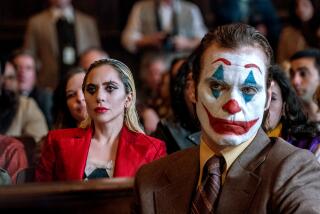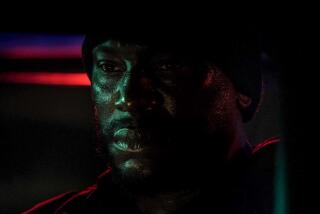MOVIE REVIEW : Logic Takes a Holiday in ‘Die Hard 2’
- Share via
In order to let go and really get into “Die Hard 2” (citywide), it’s necessary to take one’s willing suspension of disbelief, hit it over the head with a blunt instrument and bury it three miles underground. This is the most cheerfully preposterous film of a jaw-dropping summer, which is not to say it’s not fun, it’s simply orchestrated Looney Tunes.
Even Bruce Willis’ redoubtable detective, John McClane, keeps shaking his head over his part in all the action, muttering incredulously, “How can the same thing happen to the same guy twice?” as though just mentioning it is enough to get the writers off the hook.
McClane, that resourceful one-man demolition team, has once more been pressed into saving a large section of the free world--and his nifty wife. Again inadvertently and again single-handedly. The only man who seems capable of stopping him is on his side, sort of: Capt. Carmine Lorenzo (Dennis Franz, quickly recognizable from “Hill Street Blues”), apoplectic head of a huge Washington airport’s police force, who may just possibly bellow McClane into insensibility, and us along with him.
Otherwise, neither snow, nor sleet, nor hand grenades, nor airport power failures, nor ninja terrorists, nor low-flying 747s, nor Latin American drug lords, nor cataracts of flying glass, nor inexhaustible rounds of machine gun fire, nor battalions of sled-driving ski troops give John McClane so much as a headache this big.
Christmastime at this D.C. airport finds McClane arriving to meet his wife Holly (Bonnie Bedelia), traveling on the same plane with Mr. Journalistic Irresponsibility, “Die Hard’s” TV blabbermouth Dick Thornberg (William Atherton). In the air, the two have to be kept far apart; his prying reportorial techniques have made her slap him with a restraining order somewhere around “Die Hard 1-1/2.” It’s a nice touch since it redefines Holly McClane’s character as fine and feisty, a point underlined by having the splendid Bedelia back again in the role.
Meanwhile on the ground, every door of a handy airport motel bursts open in turn and a cadre of identically schooled right-wing paramilitary fanatics, carrying identically-sized Christmas packages and scowling identical paramilitary fanatic scowls, quick-marches into the airport. Does anyone give this Wehrmacht tour group a second glance? Noooooooooooo.
Luckily for all concerned, John McClane does. The granite face of their leader, Colonel Stuart (William Sadler), sets off some sort of I.D. alarm in McClane’s memory, so he follows two of Stuart’s boys back to the chutes and slides of airport hell, where the luggage of civilians like you and me circles forever. There, in spite of the fact that a backstage gun battle might just ruin Stuart’s intricately detailed plans to subvert the government’s arrest of Gen. Ramon Esperanza (Franco Nero), a Noriega-like strongman flying in under armed guard, a gun battle is just what erupts.
And so the melee begins. And if you can’t check all common sense at this point, to be claimed in two hours, if you can produce your baggage checks, you might as well give up right here. This marks Finnish-born director Renny Harlin’s move over from “Nightmare on Elm Street 4” to the really big stuff, and it’s as though writers Steven E. de Souza and Doug Richardson had given him one of everything except boa constrictors and quicksand pits as his graduation exercise.
Harlin responds with direction that’s crunchingly effective; having set his juggernaut onto its greased tracks, he’s been careful that nothing gets in its way through to its last credits--as Sibelius’ (ahem) “Finlandia” booms majestically in the background.
With flawless technical collaboration, Harlin gets airport control towers and dark New England churches to look rich and brooding for his mostly nighttime action scenes; his fireballs detonate with hell’s own roar, his stunts may be hilarious but they’re show-stoppers, and against all odds, a few of his actors manage a little humanity in all the din: Art Evans as the airport’s chief engineer, rumbling-voiced Fred Dalton Thomas as boss of the air traffic controllers and Sheila McCarthy as a principled television journalist. Reginald VelJohnson, as McClane’s LAPD phone-pal reprised from the first film, is back with far too little to do considering the warmth he projects.
Willis himself is the action hero possessed; dogged, ingenious, Teflon-coated; working hard to be real, to create a private ironic framework from which to face all the action mind-bogglers, and succeeding. It would be nice if he had a villain who’s his equal. Sadler’s cool sadistic death’s head is certainly not that; he makes you fairly yearn for the pussycat smoothness of Alan Rickman’s multiaccented terrorist in Part 1.
But all in all, “Die Hard 2” (rated R for language, violence) is a lively three-ring circus; just don’t be fussy about logic or timing, and for heaven’s sake, watch out for falling glass.
“DIE HARD 2” A Twentieth Century Fox release of a Gordon Co./Silver Pictures production of a Renny Harlin Film. Producers Lawrence Gordon, Joel Silver and Charles Gordon. Executive producers Lloyd Levin, Michael Levy. Director Renny Harlin. Screenplay Steven E. de Souza, Doug Richardson, based upon the novel “58 Minutes” by Walter Wager; certain original characters by Roderick Thorpe. Camera Oliver Wood. Production designer John Vallone. Supervising editor Stuart Baird. Editors Baird, Robert A. Ferretti. Music Michael Kamen. Costumes Marilyn Vance-Straker. First assistant director Terry Miller. Art director Christiaan Wagener. Set decorator Robert Gould. Sound Tim Cooney. With Bruce Willis, Bonnie Bedelia, William Atherton, Reginald VelJohnson, Franco Nero, William Sadler, John Amos, Dennis Franz, Art Evans, Fred Dalton Thompson, Sheila McCarthy.
Running time: 2 hours, 04 minutes.
MPAA-rated: R (under 17 requires accompanying parent or adult guardian).
More to Read
Only good movies
Get the Indie Focus newsletter, Mark Olsen's weekly guide to the world of cinema.
You may occasionally receive promotional content from the Los Angeles Times.










